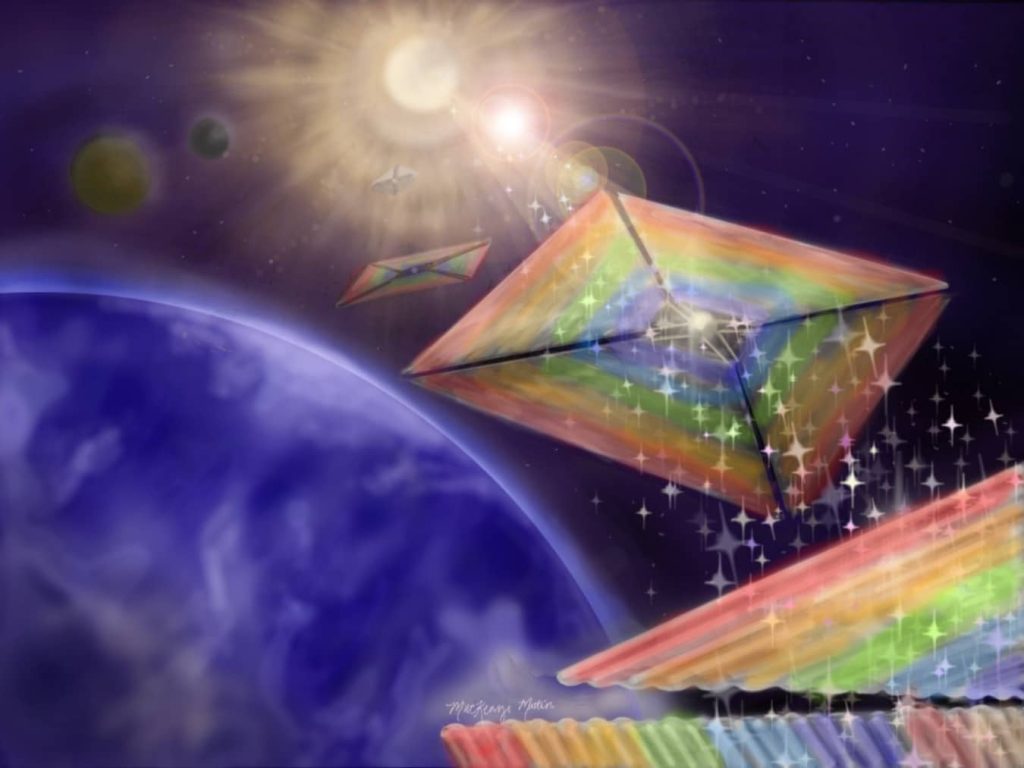In a program Advanced innovative NASA concepts (NIAC), the US space agency has selected a solar sail project that could open the way to new destinations. This innovation, called Diffractive Solar Sail, could be more efficient than existing solar sails. Thanks to the phenomenon of diffraction, it can make optimal use of all the collected sunlight. So a spacecraft equipped with this sail will be more efficient and maneuverable.
Most spacecraft today run on rocket fuel or ion engines. So it’s strange to imagine a sailing ship traveling through space. However, the solar propulsion system has already proven itself. Of course, due to the low output thrust, this device will not allow the device to leave Earth, but it is fully usable on devices in orbit or that have reached escape velocity.
This concept was specifically tested by the Japan Aerospace Agency (JAXA), which was launched in 2010 His ship IKAROS Equipped with a polyimide sail of 200 square meters covered with solar cells on 10% of the roof. This technology demonstration is intended to evaluate the performance of this type of payment. Recently, The Planetary Society – a global non-profit organization dedicated to space exploration – tested solar navigation with two projects, LightSail 1 and light sail 2, which were launched in 2015 and 2019, respectively. LightSail 2 continues its mission today and makes it possible to collect basic data about this payment mode.
A sail based on the phenomenon of diffraction
Shade sails work with the pressure that photons of sunlight exert (called radiative pressure) when they hit their surface. This force is relatively weak, but the larger and more reflective the sail, the greater the increase (if the particle is reflected rather than absorbed, it transmits twice its momentum). By adjusting the inclination of the sail, it is possible to act on the force exerted – by presenting a sail surface more or less with light – and thus to steer the ship (like a sailboat).
The main advantage of this method of propulsion is that it is possible to do without fuel, which gives the ship a very long range to explore the solar system. However, this concept has certain limitations: thrust is maximum only when the rays of light are directed directly at the sail. Thus, maneuverability is limited, since a ship equipped with such a sail cannot move in any direction.
Refractive Solar Sail Project Specifically designed to get around this “bug”. In fact, this technique takes advantage of the phenomenon of diffraction of light. When light waves encounter the edges of an obstacle (for example, a slit or other narrow gap on an opaque plate), they are deflected from their original path and scattered in different directions on the other side. This is exactly the effect that this new solar sail is looking for: it will therefore consist of several small networks embedded in thin films, which will distribute the received light over the entire sail. In theory, this would allow the spacecraft to use sunlight more efficiently without sacrificing maneuverability.
This technology could make it possible to visualize missions to places that are particularly hard to reach with traditional propulsion patterns, such as orbits around the solar poles. Scientific instruments placed in this position will improve our understanding of the Sun, as well as our ability to predict space weather.
Important solar physics project
† Exploring the universe means we need new tools, new ideas, and new ways to get around † Jim told Reuters in a statement, associate director of NASA’s Space Technology Mission Directorate (STMD). That is why NASA does not hesitate to invest in the most innovative and promising projects. † Our goal is to change what’s possible, and Solar Split Sail promises to do just that for some new and exciting mission applications. Mike LaPointe, NIAC Acting Program Director, added.
With the fission solar sail selected for the third phase of the NIAC program, the project team — led by Amber Dobell of the Johns Hopkins University Applied Physics Laboratory in Laurel, Maryland — secured $2 million in funding over two years to further develop it. Technique.
The sail must be strong and light. Thanks to the phenomenon of diffraction, it can be even smaller than the solar sails tested so far. Dobell and colleagues have already designed, manufactured, and tested several types of refracting materials. Their new funding will improve these materials. Several ground tests are also planned to better prepare future missions.
The team is confident that its eagle sail will provide unparalleled solar monitoring capabilities; It also plans to place an entire constellation of reflective solar sails around the sun to collect images and other data. † With our team’s combined expertise in optics, space, conventional solar sail and metamaterials, we hope to enable scientists to study the Sun like never before. said the project manager.
source : NASA

“Thinker. Coffeeaholic. Award-winning gamer. Web trailblazer. Pop culture scholar. Beer guru. Food specialist.”







More Stories
Sony promises thick sound from thin speakers in its new home cinema lineup
Print digital photos yourself: why and how?
LEVEL-5 postpones the VISION 2024 show until “summer 2024”